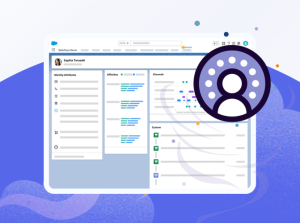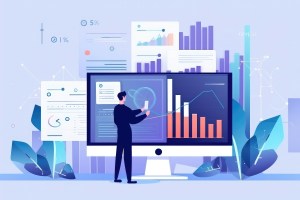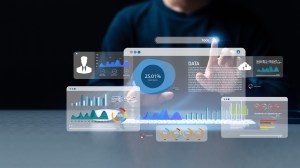Are You Maximising Efficiency in Data Analytics? Learn How



If you use customer data in your day job, you’ll have heard of data analytics. But what exactly is it? And are you using it efficiently?
Salesforce EMEA
You could quickly scan a single datasheet showing how often people have clicked on your social media advertisements to see who seems most interested in your products. But imagine you’ve multiple datasheets for different platforms, products, and locations. And you need to identify one thousand prospects, not one. Quickly, the challenge scales out of hand and carrying out the task no longer makes financial sense. You need a method of sorting through all the data efficiently.
Enter data analytics. The Salesforce Data Culture Playbook 2023 shows that, globally, 75% of business leaders agreed that if more organisations consistently leveraged analytics to make data-driven decisions, they’d achieve significant revenue gains.
Learn how data analytics can uncover valuable insights, explore different types of analytics, and enhance sales efficiency for improved effectiveness.
How to Leverage Data Analytics for Informed Decision-Making?
Data analytics might seem like rocket science, but it needn’t be. You know what data is: facts and figures and information. And you know what analytics is: analysing facts and figures and coming to conclusions. So, put them together and data analytics is when you simplify or visualise raw data to understand it better, which helps with decision-making through data-led recommendations.
We call these data-driven insights. Essentially, that means using facts rather than opinions to guide business decisions — helping you avoid relying on the Highest Paid Person’s Opinion (the HIPPO). When you’re objective instead of subjective, you get better outcomes. Our Untapped Data Research 2023 shows that, globally, 73% of business leaders agree that data helps make accurate decisions.
If you use a CRM (Customer Relationship Management) system, data analytics plays a key role. By analysing customer interactions, purchase history, and demographic data, for example, sales professionals can identify potential leads, forecast sales opportunities, and personalise their approach to each customer. If you were to do this manually, finding information for each customer using raw data, it’d be an incredibly laborious, tedious, and time-consuming process.
Not only does it help with initial outreach, but data analytics helps you track your progress and make data-driven adjustments to improve sales outcomes. This is why our research shows 83% of CEOs want a data-driven organisation.
Sell Smarter with Sales Analytics Built Directly into Your CRM
Want to accurately forecast and understand trends using contextual data and relevant insights from internal and external sources to take action on deals?


How Can Big Data Analysis Revolutionise Customer Understanding and Satisfaction?
If you’re exploring data analytics, you’ve probably heard the term big data too. It’s the countless amount of information circulating on computers and the internet. “Big” doesn’t even begin to describe the petabytes of information our society is creating; “enormous” would be way more fitting! And when you’re looking for interesting conclusions and meaningful analyses, digging into big data is where you’ll find what you need.
Big data is “big” for many reasons. One is its sheer volume. The amount of data companies generate is increasing in leaps and bounds. The Salesforce State of Data and Analytics report shows it’s predicted to grow at an average of 22% just over the next 12 months. Getting your arms around that much data is a huge challenge!
Another reason it’s “big” is because it changes so rapidly and comes in so many different formats. Data like a banking transaction is relatively easy to analyse, but what if it’s combined with the emails the bank receives, the likes the daily bank blog gets, and statistics about the companies the bank’s customers do business with? Trying to analyse all of that data together is like trying to figure out the individual ingredients of a meal you just enjoyed. It’s hard!
But while big data is tricky to analyse, the rewards of doing so are also much bigger. Analysing large sets of information can reveal previously invisible insights that are hidden in the chaos of company data. Take big data in CRM as an example. The customer data analysis from calls, emails, social media, and past sales interactions can help you to properly understand your customers — and when you can do that, it’s so much easier to keep them happy.
Types of Data Analytics
There isn’t just one type of data analytics, there are many. The most common four are: descriptive, diagnostic, predictive, and prescriptive analytics. The method you use depends on the questions you want to answer with your analysis. Descriptive and diagnostic analytics analyse the past, and predictive and prescriptive analytics look to the future. In short:
- Descriptive analytics shows you what happened in the past.
- Diagnostic analytics helps you understand why something happened in the past.
- Predictive analytics predicts what outcomes are most likely to happen in the future.
- Prescriptive analytics provides actions you can take to affect future outcomes.
From a business perspective, you’ll probably find you’re more interested in predictive and prescriptive analytics. That’s because they can help you identify opportunities to improve future business outcomes. For example, with integrated CRM data you might use predictive analytics to determine which customers are most likely to stop buying your products, giving your sales reps the opportunity to engage with them before that actually happens to try and change their mind.
So, what are some typical tools for data analytics? Well, we can’t speak for everyone, but with our AI tool Einstein, you can:
- Never run out of space: Einstein scales for your data.
- Find an option to meet your needs, since there are a variety of Einstein products.
- Automatically discover relevant patterns.
- See patterns in your data visually with Einstein and Tableau.
Activate all your Customer Data across Salesforce Applications with Data Cloud
How can you connect all your data for rigorous analysis to empower teams to act on relevant insights?


How Do You Make Data Analytics More Efficient?
Honey, I Shrunk the Data!
In the past, data analytics was limited (literally!) by the size of the data. A hard drive, thumb drive or CD could only hold a limited amount of information. Even if that number increased, there was always more data available than the device could hold.
That meant you had to compromise your analysis to fit storage limitations. Either you used a subset of your data or only the most recent data. No matter what, you had to choose. And trying to figure out why last quarter’s sales went down by hacking at a spreadsheet with year-old data would be like trying to drive while only looking in the rear-view mirror.
But with cloud computing, you no longer have to choose between having room to store more data and getting data-driven insights. For example, with Salesforce Sales Cloud, you can access all your CRM data through one app. And more data from more sources means richer analysis.
Data Analytics is a Team Sport
It’s rare to only have one data analyst at a company, especially if they’re analysing big data. So how do you know whose analysis is the most recent?
When everybody is working on their own spreadsheets, it can be nearly impossible to tell. But looking at data stored in a cloud means you can keep everyone’s work up to date and all your colleagues in sync. It’s a safer and less error-prone way of working, which is especially important given the State of Data and Analytics Report 2023 shows that only 43% of business leaders globally have complete confidence in their data’s accuracy. And if your data isn’t accurate, how can you possibly trust its results? In that case, you might as well go back to the HIPPO — and that’s something you definitely don’t want to do!
Data Analytics is for Everyone
Now, it’s fair to ask: what does a data analyst do? Because, between the sheer volume of the data and the complexity of analysing it, it might seem like you need a PhD in maths to be one. The good news is, you don’t. With the right technology, like Einstein 1, you can look at the data yourself and create your own analysis - without an advanced degree.
Reaching Your Mission with Data Analytics
As you’ve heard, data analytics is the method by which you gain value from your data. You might not use the term ‘data analytics’ on a day-to-day basis in sales, but you’ll use the fruits of its labour, gleaning insights through a tool such as Data Cloud. It’ll give you the guidance you need to personalise your outreach, fill it with relevant and timely content, and then send it at a good time on the right channel. It allows you to go a bit deeper and provide that much more value to your customers and potential customers. So, it’s critical for your success in your mission to close more deals.
To find out more about data analytics from Salesforce, visit this page.





















